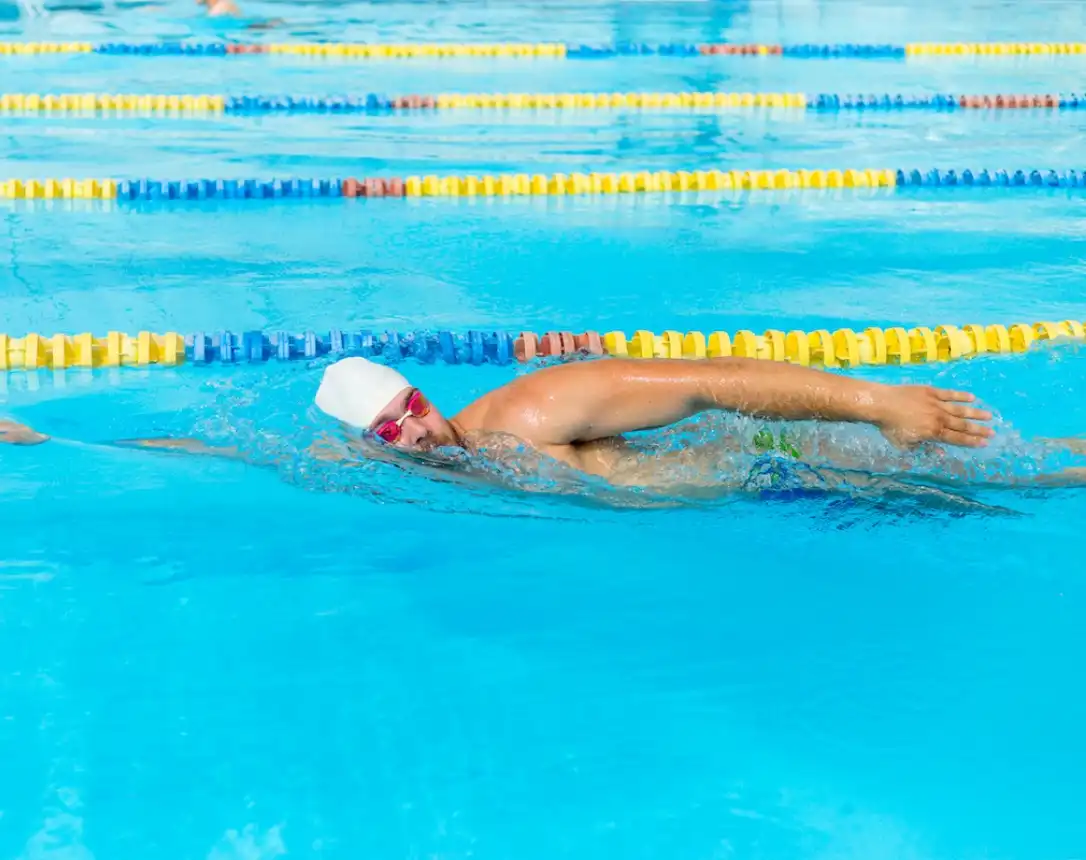Dive into the graceful world of sidestroke swimming, a technique as efficient as it is elegant. Ideal for lifesaving and leisurely swims, sidestroke allows you to glide through the water with ease, conserving energy while covering distances.
Whether you’re looking to improve your aquatic skills or seeking a gentle way to enjoy the pool, sidestroke swimming offers a unique blend of relaxation and exercise. Join us as we explore the gentle rhythm of this classic stroke, inviting swimmers of all levels to master the art of swimming side by side with the waves.
Introduction to Sidestroke
I’ve always been captivated by the elegance of the sidestroke. It’s a swimming stroke offering both efficiency and a bit of historical charm. Let’s dive right into what makes the sidestroke so unique.
Definition of Sidestroke
Sidestroke is a relaxed yet powerful swimming technique wherein I alternate sides with each stroke, gliding through the water seemingly without effort. My body stays on one side, using a scissor kick and coordinated arm movements to propel myself forward. It’s known for its stealthy, quiet approach, often used by lifeguards for rescue missions.
Historical Background
The sidestroke has deep historical roots. It emerged before strokes like the freestyle and breaststroke became the vanguards of modern swimming competitions. It’s amazing to consider that it even predated them as the preferred method for long-distance swimming, helping our ancestors traverse rivers and channels with minimum fatigue.
Comparing Sidestroke with Other Strokes
When I compare the sidestroke to freestyle or breaststroke, I notice it’s much less about speed and more about endurance and energy efficiency. Unlike the forward-facing power of freestyle or the symmetrical motion of breaststroke, my sidestroke maintains a low profile in the water, making it distinctive and less taxing on the shoulder joints.
Fundamentals of Sidestroke
Mastering the sidestroke calls for a symphony of precise movements and breath control. I’m excited to dive into the nuts and bolts of this unique stroke that weaves together balance, power, and coordination.
Body Positioning and Alignment
In sidestroke, my body lies sideways in the water, maintaining a streamlined position. It’s vital to balance my body to reduce drag. I keep my head in line with my spine, looking straight ahead, and ensure that my body doesn’t roll too much as I glide through the water.
Breathing Technique
Timed breath is the cornerstone of my power in the water. I time my breath with my arm strokes, inhaling as my leading arm completes the pulling phase and my trailing arm is extended. This allows me to maintain a rhythm that fuels my swim with oxygen without breaking my form.
Arm Movements and Coordination
My leading arm (closest to the bottom of the pool) performs a pulling motion while my trailing arm (closest to the surface) pushes, coordinating perfectly with my leg movements. I keep my upper arm strong and focused on the pull, while my lower arm extends forwards, ensuring each stroke maximizes the power I need for propulsion.
Leg Movements: Scissor Kicks
The crux of my propulsion in sidestroke is the scissor kick. Beginning with my legs together, I snap one leg forward and the other back, slicing through the water to create a powerful boost. This kick is timed with my arm strokes to ensure maximum thrust as I aim for efficient, energy-saving swims.
Learning and Perfecting the Sidestroke
Diving into the world of sidestroke swimming takes a dash of enthusiasm and a sprinkle of dedication. I’m about to unlock a rhythmic dance in the water that’s a perfect blend of energy efficiency and speed—ideal for lifeguards, triathletes, and fitness swimmers alike.
Starting Out: Tips for Beginners
- Get Comfortable: Before I even start stroking, it’s crucial to get comfortable floating on my side, fully extended.
- Leg Movement: It’s all in the scissors kick. I practice this move on the poolside or with a kickboard to nail the motion.
- Arm Coordination: My leading arm should extend forward in the water, while my trailing arm remains close to my body, aiding in propulsion.
Advanced Techniques for Improvement
- Breathing: I time my breaths with my strokes, aiming for a smooth, uninterrupted rhythm.
- Drills: To enhance my technique, I incorporate specific drills that focus on the catch and pull phases of the arm movements.
- Regular Feedback: Regular check-ins with a swimming instructor can pinpoint areas I need to tweak for that extra edge.
Common Mistakes and How to Avoid Them
- Ignoring Body Rotation: A stable body rotation enhances my stroke effectiveness. I ensure my body rolls as one unit.
- Mismatched Timing: Synchronizing my arms and legs is like conducting an orchestra; harmony is key. I practice drills to keep them in sync.
- Poor Alignment: Keeping my body streamlined reduces drag. I’m mindful of my head position, keeping it natural and in line with my spine.
Sidestroke for Fitness and Training
I’ve found that incorporating the sidestroke into my fitness regimen has revolutionized my approach to exercise and training. It’s a superb way to enhance endurance, boost energy, and master long-distance swimming with maximum efficiency.
Utilizing Sidestroke for Exercise
Let me share with you how the sidestroke serves as an excellent, low-impact exercise ideal for all fitness levels. It’s brilliant for those days when I want to give my joints a rest but still crave a thorough workout. By engaging different muscle groups, it ensures I get a balanced session in the pool. Check out this list of exercise benefits when practicing sidestroke:
- Full-body workout: Engages core, legs, and stabilizing muscles
- Improved coordination: Harmonizes breathing with synchronized limb movements
- Less strain: Ideal for injury recovery periods
- Elevates heart rate: Great for cardiovascular health
Incorporating Different Drills
To keep my training engaging, I like to mix up my routine with various drills that utilize the sidestroke. Here’s a table of drills I incorporate to refine my technique and prevent plateauing:
| Drill Name | Focus Area | Description |
|---|---|---|
| Single Arm Drill | Arm technique | Practice sidestroke using one arm at a time to improve arm strokes |
| Kickboard Drills | Leg strength | Hold a kickboard and concentrate on leg movements |
| Timing Practice | Coordination | Work on the timing of breaths with strokes for efficiency |
- Single Arm Drill: Perfect for zeroing in on arm strokes
- Kickboard Drills: They isolate the legs, enhancing propulsion.
- Timing Practice: This improves the rhythm of my breathing and strokes, making my movements more efficient.
Building Endurance and Strength
To really reap the benefits of sidestroke for fitness, I focus on incrementally increasing my practice to build endurance and strength. I usually start with a few laps and then progressively add more as my energy levels and stamina improve. By tracking my progress, I see significant improvements in my capability for long-distance swimming. Here’s how I strategize my sessions:
- Set Goals: Start with manageable distances then gradually increase.
- Consistent Practice: Maintain a regular schedule to cement gains.
- Rest and Recovery: Intersperse days of high intensity with lighter sessions or rest.
Through steady dedication to the sidestroke, I’ve experienced remarkable gains in my overall swimming efficiency and enjoy every stroke along the way!
Practical Applications of Sidestroke
I’ve discovered that the sidestroke holds significant value beyond mere recreation. It’s a versatile swimming style that offers tangible benefits in various demanding scenarios. Let’s examine these applications more closely.
Lifesaving and Lifeguard Techniques
As a swimmer focused on aquatic safety, I find the sidestroke particularly effective for lifesaving and rescue operations. Lifeguards widely use this technique as it allows one arm to remain free, helping them tow a rescue buoy or a person in need with ease. This lifesaving technique conserves energy, enabling a rescuer to swim longer distances during a mission.
- Main Advantages:
- One arm remains free for rescues
- Energy-efficient for longer operations
- Superior visibility of the victim and surroundings
Military Uses: Combat Sidestroke
When it comes to military applications, specifically among Navy SEALs, the combat sidestroke is paramount. Developed for stealth and efficiency, it allows a SEAL to swim while barely making a ripple – crucial for missions requiring a discreet approach. This sidestroke variation is part of their crucial skill set for survival and tactical advantages in water-based operations.
- Key Features:
- Minimal water disturbance for stealth
- Sustains energy for extended missions
- Integral to Navy SEAL survival training
Sidestroke in Long-Distance Swimming
Lastly, in the realm of long-distance swimming, the sidestroke is a jewel. I rely on it for practicality and endurance. It’s less taxing on the shoulders compared to other strokes, which is why swimmers often use it as a resting stroke during lengthy swims.
- Benefits for Long Distances:
- Reduces shoulder stress
- Helps swimmers conserve energy
- Allows for steady pacing over long distances
Enhancing Sidestroke Performance
Unlocking the potential for peak performance in sidestroke swimming excites me; I’m here to share how to merge power with grace to slice through the water. I’ll focus on achieving a seamless blend of efficiency and speed, transforming each stroke into a more propulsive and less taxing effort.
Exercises for Better Balance and Glide
Balance drills:
- Single arm lead: Keep one arm extended forward while the other rests on your side. Practice alternating strokes, fine-tuning your body’s lateral balance.
- Head lead: With arms at your side, propel forward using only the flutter kick and subtle body rotation. This will promote a better glide and overall core stability.
Maximizing Propulsion Efficiency
Focusing on the pull:
Remember, it’s all about making the most out of every movement.
- Concentrated stretching: Ensure each stroke begins with a complete arm extension, maximizing the length of your pull.
- Power pockets: Utilize the natural “pockets” of water resistance to enhance your underwater arm pull, increasing efficient propulsion.
Reducing Drag for Increased Speed
Streamline adjustments:
Shape is everything when it comes to cutting through the water.
- Tuck your chin slightly to align the head with your spine.
- Keep elbows close to the body during recovery to minimize frontal resistance.
Wear appropriate gear:
Sporting the right swimwear can make a difference. Look for snug, drag-reducing designs to maintain a high speed with less energy expenditure.
Additional Elements of Sidestroke
Ever since I mastered the basics of sidestroke swimming, I’ve found whole new layers of technique that amplify my experiences in the water. Whether I’m in a pool or open water, the subtle nuances of this stroke can make a world of difference.
Adapting to Various Swimming Environments
In a pool, the controlled environment allows me to focus on perfecting my movements. Here’s what I keep in mind:
- Balance: I ensure my body stays leveled to prevent unnecessary drag.
- Push Off: A powerful push off from the pool wall sets the rhythm for my entire lap.
For open water swimming, conditions are less predictable, requiring a few modifications:
- Rotation: I adjust the rotation of my body to maintain balance against waves.
- Body Movements: Longer, more deliberate strokes help me navigate through changing currents.
Psychological Benefits: Relaxation and Focus
Swimming sidestroke becomes almost relaxing as I slip into a rhythm:
- Flow State: I often find myself in a meditative state when I focus on the repetitive motion.
- Connection to Water: Feeling the push and pull of the water against my skin keeps me present and focused.
Sidestroke’s gentle rotation and asymmetrical style can truly be a dance in the water. With each stroke, I’m not just moving; I’m expressing a silent harmony with the aquatic world around me.
FAQ – Frequently Asked Questions
Is sidestroke swimming good for beginners?
Absolutely! It’s gentle on the body and easy to learn, making it perfect for beginners and those seeking a low-impact workout.
How does sidestroke swimming benefit my body?
It evenly works out both sides of your body, improving flexibility and strength without straining your joints.
Can sidestroke swimming improve my endurance?
Yes, its efficiency and lower energy consumption make it ideal for building endurance and long-distance swimming.
Thanks for joining us on this journey into sidestroke swimming. We’d love to hear about your experiences or see your progress – leave a comment below or share with us on Instagram or Pinterest!






